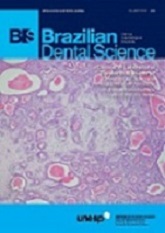Ultimate tensile strength and microhardness of glass ionomer materials
DOI:
https://doi.org/10.14295/bds.2014.v17i1.949Abstract
Objective: This study evaluated the ultimate tensile strength (UTS) and microhardness (µKH) of conventional (CO) and hybrid resin-modified glass ionomer (RM). Material and methods: Nine specimens to UTS and twelve for µKHN of glass ionomer materials were obtained using special molds. The materials were manipulated and CO groups were allowed to self-cure for five minutes and RM were subjected to light-activation as indicated by manufactures through a glass slide. All specimens were dark-stored in 100% relative humidity for 24h. For UTS test, specimens were tested in tension in a universal testing machine (crosshead speed of 1 mm/min) until failure. For µKHN test a Knoop diamond indenter was used to make five indentations in the upper/light irradiated surface of the specimens. UTS and µKHN data were submitted to one-way ANOVA, followed by Tukey’s test (?= 5%). Results: The results for UTS were: Ionomaster: 7.0 (±1.6)A; Maxxion R: 8.8 (±3.7)A Vidrion R: 8.8 (±3.9)A; ChemFil Rock: 10.7 (±4.6)AB; Vitremer: 13.1 (±3.3)BC; Vitrofil R: 14.9 (±7.8)CD; Ionoseal: 14.5 (±8.2)CD; Resiglass: 16.3 (±2.3)D. The results for µKH: Ionomaster: 24.3 (±6.6)B; Maxxion R: 17.7 (±4.7)A, Vidrion R: 31.0 (±9.4) B; ChemFil Rock: 31.1 (±8.5)B; Vitremer: 20.3 (±3.3)A; Vitrofil R: 16.5 (±5.1)A; Ionoseal: 13.1 (±8.5)A; Resiglass: 21.6 (±5.2)A. Conclusion: It was observed that the hybrid resin-modified ionomers generally have higher cohesive strength than conventional ones, but lower microhardness.
Downloads
Downloads
Published
How to Cite
Issue
Section
License
Brazilian Dental Science uses the Creative Commons (CC-BY 4.0) license, thus preserving the integrity of articles in an open access environment. The journal allows the author to retain publishing rights without restrictions.
=================




























